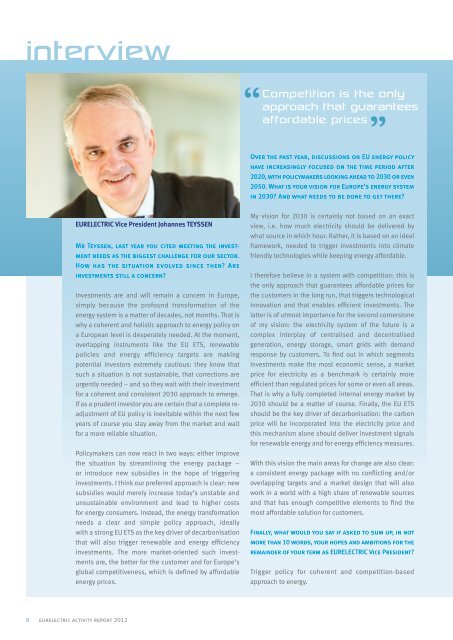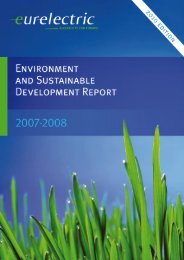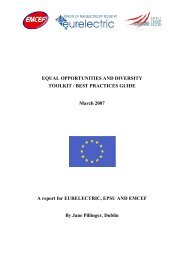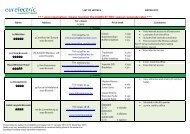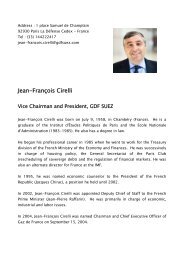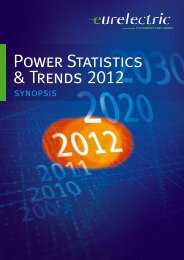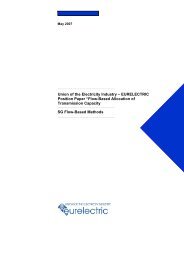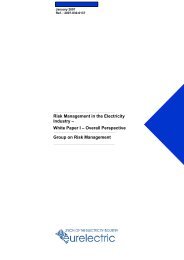Activity Report 2012 - Eurelectric
Activity Report 2012 - Eurelectric
Activity Report 2012 - Eurelectric
Create successful ePaper yourself
Turn your PDF publications into a flip-book with our unique Google optimized e-Paper software.
interview<br />
EURELECTRIC Vice President Johannes TEySSEn<br />
Mr Teyssen, last year you cited meeting the investment<br />
needs as the biggest challenge for our sector.<br />
How has the situation evolved since then? Are<br />
investments still a concern?<br />
Investments are and will remain a concern in Europe,<br />
simply because the profound transformation of the<br />
energy system is a matter of decades, not months. That is<br />
why a coherent and holistic approach to energy policy on<br />
a European level is desperately needed. At the moment,<br />
overlapping instruments like the EU ETS, renewable<br />
policies and energy efficiency targets are making<br />
potential investors extremely cautious: they know that<br />
such a situation is not sustainable, that corrections are<br />
urgently needed – and so they wait with their investment<br />
for a coherent and consistent 2030 approach to emerge.<br />
If as a prudent investor you are certain that a complete readjustment<br />
of EU policy is inevitable within the next few<br />
years of course you stay away from the market and wait<br />
for a more reliable situation.<br />
Policymakers can now react in two ways: either improve<br />
the situation by streamlining the energy package –<br />
or introduce new subsidies in the hope of triggering<br />
investments. I think our preferred approach is clear: new<br />
subsidies would merely increase today’s unstable and<br />
unsustainable environment and lead to higher costs<br />
for energy consumers. Instead, the energy transformation<br />
needs a clear and simple policy approach, ideally<br />
with a strong EU ETS as the key driver of decarbonisation<br />
that will also trigger renewable and energy efficiency<br />
investments. The more market-oriented such investments<br />
are, the better for the customer and for Europe’s<br />
global competitiveness, which is defined by affordable<br />
energy prices.<br />
8 eurelectric activity report <strong>2012</strong><br />
Competition is the only<br />
approach that guarantees<br />
affordable prices<br />
Over the past year, discussions on EU energy policy<br />
have increasingly focused on the time period after<br />
2020, with policymakers looking ahead to 2030 or even<br />
2050. What is your vision for Europe’s energy system<br />
in 2030? And what needs to be done to get there?<br />
My vision for 2030 is certainly not based on an exact<br />
view, i.e. how much electricity should be delivered by<br />
what source in which hour. Rather, it is based on an ideal<br />
framework, needed to trigger investments into climate<br />
friendly technologies while keeping energy affordable.<br />
I therefore believe in a system with competition: this is<br />
the only approach that guarantees affordable prices for<br />
the customers in the long run, that triggers technological<br />
innovation and that enables efficient investments. The<br />
latter is of utmost importance for the second cornerstone<br />
of my vision: the electricity system of the future is a<br />
complex interplay of centralised and decentralised<br />
generation, energy storage, smart grids with demand<br />
response by customers. To find out in which segments<br />
investments make the most economic sense, a market<br />
price for electricity as a benchmark is certainly more<br />
efficient than regulated prices for some or even all areas.<br />
That is why a fully completed internal energy market by<br />
2030 should be a matter of course. Finally, the EU ETS<br />
should be the key driver of decarbonisation: the carbon<br />
price will be incorporated into the electricity price and<br />
this mechanism alone should deliver investment signals<br />
for renewable energy and for energy efficiency measures.<br />
With this vision the main areas for change are also clear:<br />
a consistent energy package with no conflicting and/or<br />
overlapping targets and a market design that will also<br />
work in a world with a high share of renewable sources<br />
and that has enough competitive elements to find the<br />
most affordable solution for customers.<br />
Finally, what would you say if asked to sum up, in not<br />
more than 10 words, your hopes and ambitions for the<br />
remainder of your term as EURELECTRIC Vice President?<br />
Trigger policy for coherent and competition-based<br />
approach to energy.


